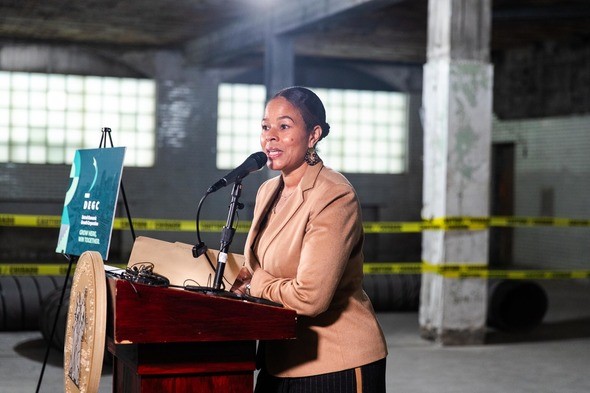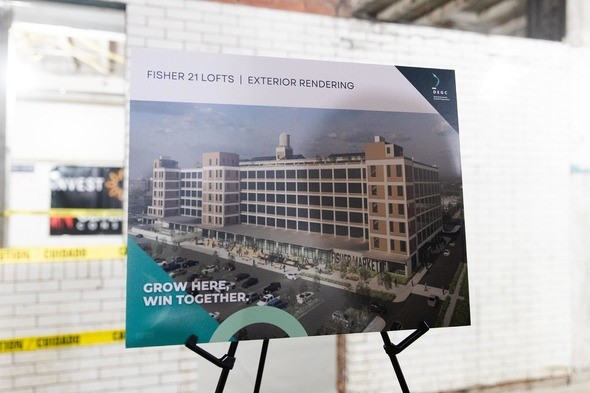A groundbreaking chapter unfolds in Detroit’s history as the Detroit Economic Growth Corporation (DEGC) announces receiving a $14.5 million grant from the Michigan Economic Development Corporation (MEDC). This significant funding, part of the ambitious Revitalization and Placemaking (RAP) 2.0 program, marks a pivotal step towards rejuvenating key neighborhoods in Detroit. With a total investment exceeding $255 million, the grant will energize five major mixed-use development projects, each a beacon of potential and progress.
The stage for this announcement was aptly set at the Jefferson Intermediate School, symbolizing one of the key sites of transformation. In a compelling address, DEGC’s COO and Executive Vice President Kenyetta Hairston-Bridges highlighted the grant’s significance: “The RAP grant activates strategic Detroit developments to advance inclusive growth brick by brick,” she proclaimed. Hairston-Bridges further detailed the grant’s role in creating impactful housing, jobs, and services, vital for the upliftment of Detroiters.

Echoing this sentiment, Mayor Mike Duggan expressed his profound appreciation: “We are deeply appreciative to the MEDC for this generous grant to move these important neighborhood development projects forward, and to the DEGC for making sure Detroit developers have the support they need.” He emphasized the transformative potential of the projects, envisioning the conversion of long-vacant buildings into vibrant community and commercial centers.
These developments represent more than just construction projects; they are a testament to Detroit’s resilience and commitment to inclusive growth. They embody a city reborn, not just in its skyline but in the spirit of its communities. As Detroit embraces this new era of development, the RAP 2.0 grant is not just a financial instrument but a catalyst for hope, opportunity, and a brighter future for all Detroiters.
“The RAP grant will bring to fruition the vision we have had on Broadway Street since winning an RFP to redevelop three historic properties six years ago. We have since been designing and redesigning the project as we deal with rising construction costs and interest rates, while staying true to our original promises to respect the history of the neighborhood and create density,” said Basmajian, who also serves as president and CEO of Basco Detroit. “With this grant we will be able to save these historic buildings, while adding significant residential units and affordability in Downtown Detroit’s Paradise Valley Neighborhood. We are deeply honored and grateful for the MEDC, DEGC and Mayor Mike Duggan for supporting this project.”

The RAP 2.0 program, overseen by the MEDC, plays a pivotal role in this urban transformation. Designed to bridge the financial gaps in real estate and infrastructure development, the program offers grants up to $5 million for each real estate rehabilitation and development project. Additionally, it provides up to $1 million for public space infrastructure and up to $20 million to local or regional partners for subgrant programs. These funds, a part of a larger initiative that saw the MEDC allocating $99.2 million in October for RAP 2.0 projects across Michigan’s ten prosperity regions, must be utilized before September 30, 2027.
The five earmarked projects, a mix of commercial and residential developments, were meticulously selected based on their strategic locations, readiness, financial viability, and expected community impact. These projects underscore a commitment to mixed-use and mixed-income housing, historical preservation, and the empowerment of emerging and minority developers.
Detailed overview of the projects:
- Broadway Lofts: Spearheaded by Roger Basmajian, this project involves the conversion of three buildings on Broadway Street into a mixed-use property with 80 residential units and ground-floor retail space. Basmajian, reflecting on the journey and the impact of the RAP grant, shared, “The RAP grant will bring to fruition the vision we have had on Broadway Street since winning an RFP to redevelop three historic properties six years ago…With this grant, we will be able to save these historic buildings, while adding significant residential units and affordability in Downtown Detroit’s Paradise Valley Neighborhood.”
- Fisher 21 Lofts: Led by developers Gregory Jackson and Richard Hosey, this project aims to transform a 600,000-square-foot building into 433 residential units, along with retail and co-working spaces. It will also feature 63 income-restricted affordable housing units, catering to a diverse demographic.
- The Arthur Murray Building: Developer Emery Matthews is at the helm of this $14.9 million project, which will revitalize a historic building into 32 residential apartments and retail space. This development pays homage to the pioneering spirit of Doris Eaton Travis and the Arthur Murray Dance Studio’s legacy.
- Jefferson Intermediate School: In collaboration with Midtown Detroit, Inc. and Invest Detroit, this project aims to breathe new life into the Jefferson Intermediate School by converting it into a multi-tenant office and innovation space. Marcia Ventura, from Invest Detroit, underlined the initiative’s core ethos: “The ability to redevelop and repurpose abandoned buildings that truly benefit neighborhoods is at the heart of Invest Detroit’s revitalization strategy.”
- The Deco: This development, championed by Brandon Hodges and Damon Dickerson, involves renovating a long-vacant building on East Warren into a vibrant space featuring rental apartments and a ground-floor restaurant. It stands as a symbol of neighborhood rejuvenation and small business empowerment.
The timeline for Detroit’s ambitious development projects is rapidly taking shape. Four out of the five key projects are set to break ground in the first quarter of 2024, signaling a new phase of growth and construction in the city. Meanwhile, the Jefferson School project is already making significant strides, with construction well underway and reaching the halfway mark.
Developers will receive gap funding as they hit various milestones in their projects, ensuring a steady flow of resources and maintaining momentum. The DEGC’s role is not just financial; they are deeply involved in the process, overseeing expenditures and providing guidance to ensure each project reaches completion effectively and efficiently.
As Detroit embarks on this ambitious revamp, a critical question arises: How will these developments impact the everyday lives of Detroiters? The answer lies in the very fabric of the city’s diverse neighborhoods. These projects, by injecting over $255 million into the local economy, promise to create a ripple effect of benefits for residents. Beyond the physical transformation of neglected buildings and vacant lots, there’s a deeper, more profound change at hand. These developments are set to provide much-needed affordable housing, new job opportunities, and revitalized commercial spaces. This means that regular Detroit citizens, from young professionals seeking affordable downtown living to families looking for stable employment, stand to gain directly from this wave of development.
Furthermore, the importance of these projects extends beyond economic upliftment. They are a beacon of inclusive growth and community engagement. With a significant number of these projects led by African American developers, there’s an undeniable sense of community ownership and representation in these endeavors. This inclusive approach not only empowers minority developers but also ensures that the developments are in tune with the needs and aspirations of the local communities. It’s a step towards rectifying historic imbalances and giving Detroiters a stake in their city’s future. As these projects unfold, they’re expected to foster a sense of pride and belonging among residents, reinforcing the community bonds that are essential to the city’s identity.
Lastly, the impact of this urban revamp on Detroit’s image and appeal cannot be understated. In a city historically plagued by economic downturns and urban decay, these developments symbolize a turning point. They represent Detroit’s resilience and its ability to reinvent itself in the face of challenges. For residents, this translates into a renewed sense of optimism and confidence in their city’s future. The improved infrastructure, new public spaces, and enhanced quality of life will not only benefit current residents but also attract new businesses and talent to Detroit. This influx of new energy and ideas is crucial for the city’s ongoing regeneration, making Detroit a vibrant, dynamic place to live, work, and play. In essence, this revamp isn’t just about rebuilding structures; it’s about rekindling the spirit of Detroit and its people.
It’s a tangible manifestation of the city’s resilience and a testament to its ability to rise from adversity. For the residents, these projects are not just buildings and infrastructure; they are symbols of their city’s revival and potential. There’s a newfound pride in calling Detroit home, a sentiment bolstered by the visible transformations occurring in their neighborhoods. It’s a narrative change – from a city often defined by its struggles to one that’s shaping its own story of resurgence and renewal. This shift doesn’t just change the physical landscape of Detroit; it revamps the emotional landscape of its residents, infusing them with pride and a collective identity centered on their city’s revival.
As Detroit gears up for the upcoming NFL Draft in April, this sense of community pride is set to reach new heights. The event is a significant milestone, showcasing Detroit as a city that’s not only recovering but thriving and capable of hosting large-scale, dynamic events. It echoes the ethos of “stay ready so you don’t have to get ready,” a philosophy that Detroit has embodied in its approach to revitalization and growth. The draft will bring a spotlight to the city, attracting visitors, media attention, and economic activity, further cementing Detroit’s place as a city on the rise. For Detroiters, it’s an opportunity to showcase their city’s new face – vibrant, forward-looking, and rich in culture and history. This event, alongside the ongoing developments, is more than just an economic boost; it’s a chance for the community to demonstrate their resilience and the collective spirit that drives Detroit. It’s a moment for the city to shine on the national stage, reaffirming to its residents and the world that Detroit is ready and thriving.
About Post Author
Ebony JJ Curry, Senior Reporter
Ebony JJ is a master journalist who has an extensive background in all areas of journalism with an emphasis on impactful stories highlighting the advancement of the Black community through politics, economic development, community, and social justice. She serves as senior reporter and can be reached via email: ecurry@michronicle.com
Keep in touch via IG: @thatssoebony_